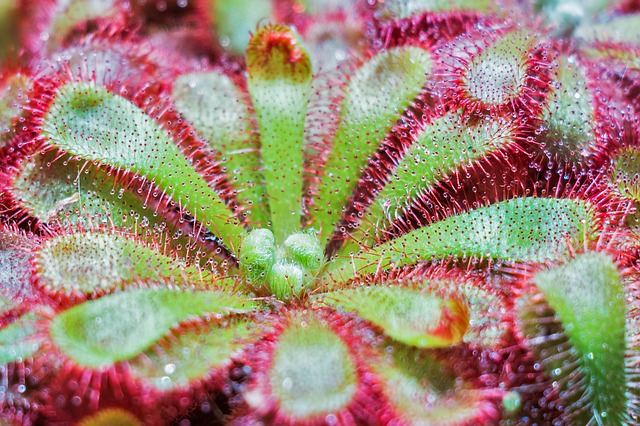
Carnivorous Plants You Can Keep at Home
If you’re looking for a unique and interesting houseplant, it’s hard to get more unique than a carnivorous plant. Unlike other plants, carnivorous plants need to “digest” animal or insect matter to get all of their nutrients. Most carnivorous plants are native to areas with extremely poor soil where they can’t get all the nutrients that they need.
Carnivorous plants attract insects with bright colors and sweet nectars. When the unsuspecting insect lands in the plant, the plant is able to slowly digest it and extract nutrients.
But keeping a carnivorous plant alive is about more than providing it with so-so soil and a few bits of hamburger. Let’s look through the logistics of keeping a carnivorous plant at home.
Can carnivorous plants survive indoors?
Yes, carnivorous plants can survive indoors. But they’re a bit more challenging than your average houseplant. If you’re a beginner or tend to kill your plants quickly, you might want to get a bit more practice before attempting to keep a carnivorous plant alive.
Most carnivorous plants evolved in humid, boggy environments with low-quality soil. You’ll need to provide them with:
- Unique, moist soil that’s highly acidic – not just normal potting soil. Make your own by combining sand and peat moss in equal parts.
- Well-draining but moist soil is a must. Gravel at the base of the pot or terrarium can help keep your plant well-drained.
- High humidity. You’ll be most successful if you provide a humid environment by putting the plant inside of a terrarium with some air flow via a gap in the lid.
- Bright but indirect sunlight. Be careful to avoid overheating the plants if you keep them inside a terrarium.
- Purified water to avoid giving the plant water that’s too alkaline or full of minerals.
- Food – usually in the form of insects. Your carnivorous plant should get a variety of insects to balance out the nutrients. Hamburger and animal meat is too high in protein. You can release crickets or other store-bought insects into the terrarium.
It might seem odd that soil can be too rich for a plant. But because carnivorous plants evolved to deal with acidic, nutrient-deficient soils, that’s what they need today! Fertilizer or rich soil can kill your plant.
Some carnivorous plants are easier to grow indoors than others. It’s best to start with the easy ones first, then add the more challenging ones to your greenhouse as you go.
Which carnivorous plant is the easiest to grow?
Most beginners start out with a Venus flytrap. This plant is the best-known carnivorous plant, with distinctive “jaws” that clamp shut on insects when they try to sample the plant’s nectar.

The problem is, Venus flytraps aren’t actually all that easy. That’s because in order to stay healthy, they need to go through dormancy ever year. Venus flytraps evolved in a temperate climate where they basically hibernate for several months per year.
If you’re keeping your Venus flytraps indoors and don’t let them go dormant during the year, they’ll die much younger (2-3 years in general). If you have a cool area of the house that stays between 35 and 55 degrees Fahrenheit, you can put your plants there for the winter. Be sure to introduce them to dormancy gradually, just like if they were in the wild. They’ll still need some sunlight. If you don’t have a space for that, it’s hard to properly care for the Venus flytrap.
Instead of trying to work through dormancy as a first-time carnivorous plant owner, consider bringing home one of these easy carnivorous plants instead:

Asian Pitcher Plants
These plants do best with warm daytime temperatures, so they often do best on patios or other toasty parts of the house. 70 to 80 degrees Fahrenheit is perfect. They like bright, indirect light and do very well in hanging baskets.
Bladderworts
These gorgeous little carnivorous plants are perfect for your home. Bladderworts have delicate white flowers and can happily grow inside teacups. You can get terrestrial or aquatic bladderworts, whichever you prefer! These hardy little plants aren’t picky about soil or drainage – they just like to have plenty of light.
These plants have some of the most complex feeding systems of all plants, so you won’t actually be feeding them like other carnivorous plants. They eat microscopic nematodes in their soil.

Butterworts
These small plants look like succulents but are actually carnivorous plants. The Mexican butterwort is the most common species around. It actually does go through dormancy, but it doesn’t need much special care during that time – you just have to stop watering and feeding it during the winter, and it will be fine.
Butterworts like indirect sunlight and very well-draining soil. Your potting mix should be closer to ¾ sand or lava rock to ¼ peat, rather than the usual 50/50 mix for other carnivorous plants.

Tropical Sundews
Tropical sundew species don’t need to go through dormancy (the temperate species do need dormancy, so steer clear if you’re not equipped for that). Alice sundews, Cape sundews, fork-leaved sundews, spoon-leaf sundews, and lance-leaf sundews all require the same, easy-growing conditions. You can even grow several different species in the same container!
Sundews love bright light and lots of clean water. Feed no more than two branches once per week. Feed them spiders, ants, crickets, and flies. Some carnivorous plant growers also feed their plants with wet betta fish pellets with great results. Read more about sundew care here.
These carnivorous plants are perfect for keeping at home. They’re easy, they don’t require dormancy, and they’re beautiful.












